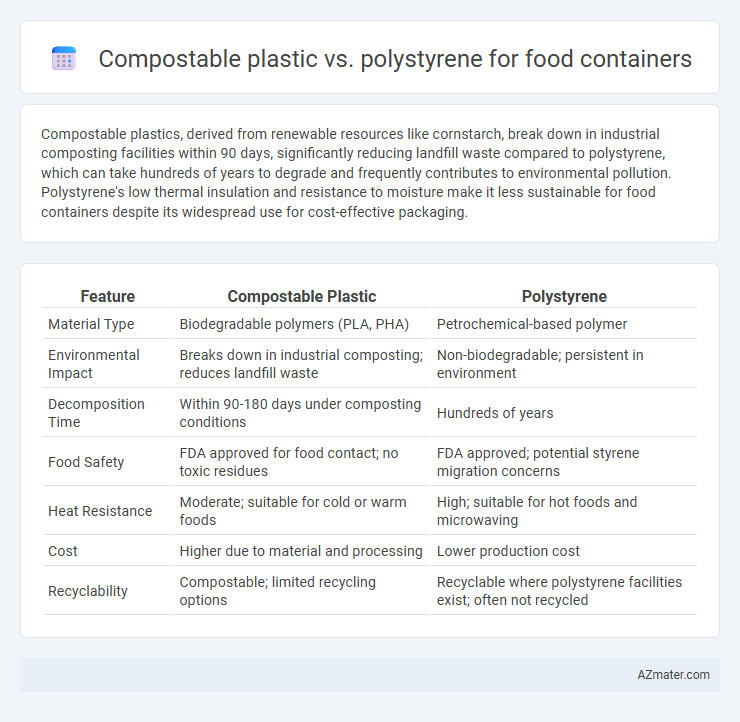Compostable plastics, derived from renewable resources like cornstarch, break down in industrial composting facilities within 90 days, significantly reducing landfill waste compared to polystyrene, which can take hundreds of years to degrade and frequently contributes to environmental pollution. Polystyrene's low thermal insulation and resistance to moisture make it less sustainable for food containers despite its widespread use for cost-effective packaging.
Table of Comparison
| Feature | Compostable Plastic | Polystyrene |
|---|---|---|
| Material Type | Biodegradable polymers (PLA, PHA) | Petrochemical-based polymer |
| Environmental Impact | Breaks down in industrial composting; reduces landfill waste | Non-biodegradable; persistent in environment |
| Decomposition Time | Within 90-180 days under composting conditions | Hundreds of years |
| Food Safety | FDA approved for food contact; no toxic residues | FDA approved; potential styrene migration concerns |
| Heat Resistance | Moderate; suitable for cold or warm foods | High; suitable for hot foods and microwaving |
| Cost | Higher due to material and processing | Lower production cost |
| Recyclability | Compostable; limited recycling options | Recyclable where polystyrene facilities exist; often not recycled |
Introduction to Food Container Materials
Food container materials significantly impact environmental sustainability and food safety, with compostable plastics offering biodegradable alternatives to traditional options like polystyrene. Compostable plastics are derived from renewable resources such as cornstarch or sugarcane, breaking down into non-toxic components under industrial composting conditions, reducing landfill waste and pollution. Polystyrene, commonly used for disposable food containers, is petroleum-based, non-biodegradable, and poses challenges in recycling, often contributing to environmental pollution and microplastic contamination.
What Are Compostable Plastics?
Compostable plastics are bioplastics designed to break down into natural elements within a compost environment, typically made from renewable plant-based materials such as cornstarch or sugarcane. They decompose through microbial activity into water, carbon dioxide, and biomass within a specific timeframe, unlike polystyrene, which is petroleum-based and resists biodegradation. Certified compostable food containers reduce landfill waste and lower environmental impact compared to conventional polystyrene containers.
Understanding Polystyrene Food Containers
Polystyrene food containers are lightweight, durable, and provide excellent insulation, making them a popular choice for hot and cold food packaging. However, these containers are non-biodegradable and contribute significantly to environmental pollution due to their resistance to natural decomposition. Compostable plastic alternatives offer an eco-friendly solution by breaking down into organic matter, reducing landfill waste and minimizing ecological impact.
Environmental Impact: Compostable Plastic vs Polystyrene
Compostable plastic food containers break down into natural elements within a composting environment, significantly reducing landfill waste and lowering greenhouse gas emissions compared to polystyrene, which can persist in the environment for hundreds of years. Polystyrene's non-biodegradable nature contributes to long-term pollution and poses risks to marine life due to microplastic formation. Lifecycle analyses indicate compostable plastics have a smaller carbon footprint and a more positive effect on soil health when properly composted.
Biodegradability and Decomposition Rates
Compostable plastic food containers break down faster and more thoroughly in industrial composting environments, typically decomposing within 90 to 180 days due to their plant-based polymers. Polystyrene, commonly used in foam food containers, can persist in the environment for hundreds of years because it is resistant to biodegradation and often fragments into microplastics without fully decomposing. Choosing compostable plastics significantly reduces landfill accumulation and environmental pollution compared to polystyrene's slow decomposition and toxic residue.
Food Safety and Health Considerations
Compostable plastics for food containers are designed to break down naturally without releasing harmful chemicals, reducing the risk of toxic contamination and supporting safer food storage. Polystyrene, commonly used in disposable food containers, can leach styrene and other potentially harmful substances into food, especially when heated, raising food safety and health concerns. Choosing compostable plastics helps minimize exposure to hazardous chemicals and promotes environmental sustainability in food packaging.
Cost Comparison and Market Availability
Compostable plastic food containers generally incur higher production costs compared to polystyrene, resulting in retail prices that are 20-40% more expensive on average. Polystyrene remains widely available and cost-effective due to established manufacturing processes and abundant raw materials, dominating the food container market with prices often half of compostable alternatives. Market availability of compostable plastics is growing rapidly in response to environmental regulations and consumer demand but still lags behind the extensive distribution networks supporting polystyrene products.
Performance and Usability for Food Packaging
Compostable plastics offer excellent biodegradability and can safely decompose in industrial composting facilities, making them environmentally friendly alternatives to polystyrene for food containers. Polystyrene provides superior insulation and rigidity, maintaining food temperature and protecting fragile items, but it lacks biodegradability and contributes to long-term environmental pollution. Compostable plastics often have limitations in moisture resistance and durability compared to polystyrene, impacting their usability for long-term or high-humidity food storage.
Regulatory Standards and Certifications
Compostable plastics for food containers adhere to standards such as ASTM D6400 and EN 13432, ensuring biodegradability and safe composting in industrial facilities, while regulatory bodies like the FDA regulate their food-contact safety. Polystyrene food containers comply with FDA regulations under 21 CFR 177.1640, which addresses the safety of styrene-based materials for food contact but face increasing restrictions or bans in regions like the EU and California due to environmental concerns. Certifications like OK Compost and Seedling validate compostable plastics' environmental claims, whereas polystyrene lacks equivalent eco-certifications, highlighting their divergent regulatory and sustainability standings.
Future Trends in Sustainable Food Packaging
Compostable plastics are rapidly gaining traction in sustainable food packaging due to their biodegradability and reduced environmental impact compared to polystyrene, which is notorious for its persistence in landfills and ecosystems. Advancements in biopolymer technology are enhancing the performance and affordability of compostable containers, driving industry adoption and regulatory support globally. Market projections indicate a significant shift toward compostable packaging, fueled by increasing consumer demand for eco-friendly solutions and stringent governmental policies aimed at reducing plastic waste.

Infographic: Compostable plastic vs Polystyrene for Food container
 azmater.com
azmater.com